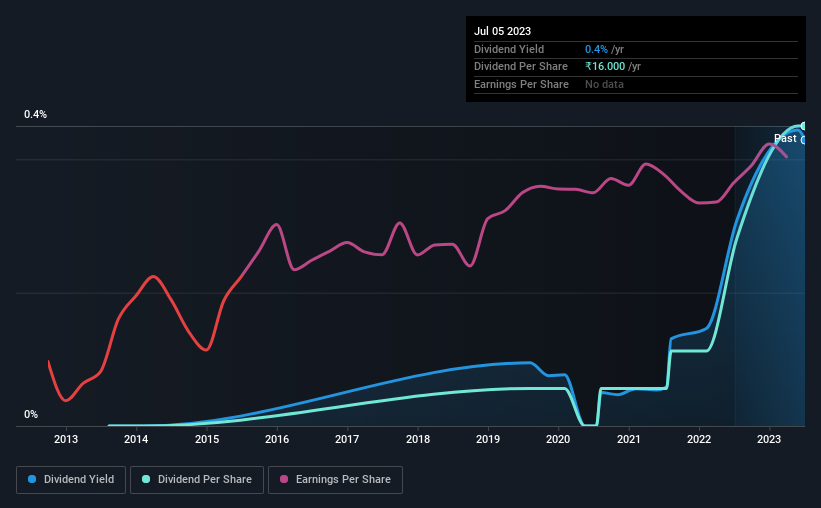AstraZeneca Pharma India's (NSE:ASTRAZEN) Dividend Will Be Increased To ₹16.00

AstraZeneca Pharma India Limited's (NSE:ASTRAZEN) dividend will be increasing from last year's payment of the same period to ₹16.00 on 13th of September. Even though the dividend went up, the yield is still quite low at only 0.4%.
Check out our latest analysis for AstraZeneca Pharma India
AstraZeneca Pharma India's Payment Has Solid Earnings Coverage
It would be nice for the yield to be higher, but we should also check if higher levels of dividend payment would be sustainable. Prior to this announcement, AstraZeneca Pharma India was quite comfortably covering its dividend with earnings and it was paying more than 75% of its free cash flow to shareholders. The company is clearly earning enough to pay this type of dividend, but it is definitely focused on returning cash to shareholders, rather than growing the business.
Over the next year, EPS could expand by 30.8% if recent trends continue. If the dividend continues on this path, the payout ratio could be 31% by next year, which we think can be pretty sustainable going forward.

AstraZeneca Pharma India's Dividend Has Lacked Consistency
Even in its short history, we have seen the dividend cut. The annual payment during the last 4 years was ₹2.00 in 2019, and the most recent fiscal year payment was ₹16.00. This implies that the company grew its distributions at a yearly rate of about 68% over that duration. It is great to see strong growth in the dividend payments, but cuts are concerning as it may indicate the payout policy is too ambitious.
The Dividend Looks Likely To Grow
Growing earnings per share could be a mitigating factor when considering the past fluctuations in the dividend. It's encouraging to see that AstraZeneca Pharma India has been growing its earnings per share at 31% a year over the past five years. AstraZeneca Pharma India is clearly able to grow rapidly while still returning cash to shareholders, positioning it to become a strong dividend payer in the future.
In Summary
In summary, while it's always good to see the dividend being raised, we don't think AstraZeneca Pharma India's payments are rock solid. The low payout ratio is a redeeming feature, but generally we are not too happy with the payments AstraZeneca Pharma India has been making. We don't think AstraZeneca Pharma India is a great stock to add to your portfolio if income is your focus.
Market movements attest to how highly valued a consistent dividend policy is compared to one which is more unpredictable. At the same time, there are other factors our readers should be conscious of before pouring capital into a stock. To that end, AstraZeneca Pharma India has 2 warning signs (and 1 which is concerning) we think you should know about. Is AstraZeneca Pharma India not quite the opportunity you were looking for? Why not check out our selection of top dividend stocks.
New: Manage All Your Stock Portfolios in One Place
We've created the ultimate portfolio companion for stock investors, and it's free.
• Connect an unlimited number of Portfolios and see your total in one currency
• Be alerted to new Warning Signs or Risks via email or mobile
• Track the Fair Value of your stocks
Have feedback on this article? Concerned about the content? Get in touch with us directly. Alternatively, email editorial-team (at) simplywallst.com.
This article by Simply Wall St is general in nature. We provide commentary based on historical data and analyst forecasts only using an unbiased methodology and our articles are not intended to be financial advice. It does not constitute a recommendation to buy or sell any stock, and does not take account of your objectives, or your financial situation. We aim to bring you long-term focused analysis driven by fundamental data. Note that our analysis may not factor in the latest price-sensitive company announcements or qualitative material. Simply Wall St has no position in any stocks mentioned.
About NSEI:ASTRAZEN
AstraZeneca Pharma India
A biopharmaceutical company, engages in manufacturing, distributing, and marketing of pharmaceutical products in India and internationally.
Excellent balance sheet low.
Similar Companies
Market Insights
Community Narratives




